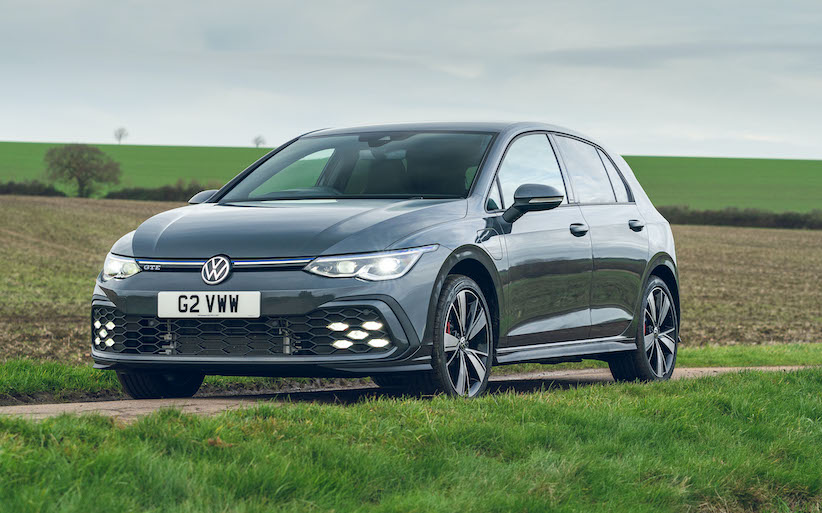Amid all the fanfare surrounding Volkswagen’s new, futuristically styled ID.3, it’s easy to forget that the brand’s hallmark Golf actually stole a march on the trendy young upstart when it launched in fully electric form way back in 2014.
Although Volkswagen has dabbled with electrification for its stalwart hatchback pretty much since its debut in the Seventies, it was only when the seventh iteration appeared that an exclusively electric option became fully integrated into the range. Available exclusively in five-door form, the e-Golf’s 24 kWh electric motor and single-speed automatic transmission delivered the equivalent of 113 bhp and a potential range of up to 118 miles, and it was complemented by a single trim level which provided a generous helping of mod cons. It’s not to be confused with the Golf GTE, a plug-in hybrid positioned as a more planet-friendly alternative to the coveted GTI and GTD models.
The e-Golf has arguably played a starring role in the evolution of electrification. By enabling drivers to experience electric driving in the innately familiar surroundings of one of the world’s most popular and trusted hatchbacks, it helped to validate the technology and boost its accessibility and appeal to a mainstream audience.
Production of the e-Golf ended in late 2020, after just over 145,000 examples had rolled off the line. The latest Golf 8 range, launched that same year, features a plug-in hybrid model, but buyers in the market for a fully electric compact hatchback are now catered for by the ID.3.
Those who can live without that car’s groovier styling and more up-to-the-minute technological trinkets will find that the honest-to-goodness e-Golf still proves to be a very viable alternative at prices now starting from around £12,000 on the second-hand market. Here’s the lowdown on what to look for when buying one used...
Prices
The e-Golf underwent a facelift in 2017 as part of a midlife update programme for the seventh generation Golf, or Golf 7, that was substantial enough for it to be unofficially rebranded as Golf 7.5. On top of some judicious styling tweaks and choice upgrades to its infotainment and driver assistance technology, it benefited from a new, larger capacity 36 kWh battery which increased its range, and a power boost from 85kW to 100kW, or from 113 bhp to 134 bhp in ‘old money’. For a bit of context, that means the car essentially started out with an output similar to the brand’s turbocharged 1.2 TSI petrol model, then moved up in the world towards the dizzier heights of the 1.4 TSI. An uplift in peak torque, or pulling power, from 270Nm to 290Nm also helped to shave the 0-62mph sprint time from 10.2 seconds to 9.6, and top speed rose by 6mph to 93mph.
Needless to say, it’s the post-2017 models boasting the upgraded technology and souped-up battery that are the most highly prized, but that definitely doesn’t mean earlier versions should be disregarded. On average, around £15,000 will secure one of these with between 20,000 and 40,000 miles on the clock, although some cars in a similar position are now dipping further towards the £12,000 mark, so they’re starting to look particularly appealing. That said, examples of the more powerful and higher-tech 2017 model can now be picked up from around £17,000, so if you can make the stretch you might want to take advantage of its greater modernity – we don’t think you’ll regret taking either course of action. For the youngest e-Golf examples with four-figure mileages, expect to pay upwards of £21,000, which still leaves around £6,000-worth of clear air between the Golf and the cheapest ID.3 once the government’s £2,500 Plug-in-Vehicle Grant has been deducted from the new car’s list price.
At launch the e-Golf was actually notable as the first production Volkswagen to be equipped as standard with all-LED headlights, which makes sense given that they drain less electrical power than their Xenon equivalents. In most other respects its equipment list mirrored the ICE-powered SE models, although it trumped these with home comforts such as two-zone climate control, front and rear parking sensors and the Discover Pro navigation system with its more generous eight-inch colour touchscreen.
The updated 2017 car made more driver assistance systems available and featured an enhanced Discover Pro system with an expanded 9.2-inch screen that was not only voice controllable but also able to respond to smartphone-style swipes and pinches. It also gained Car-Net ‘Security and Service’, enabling the driver to seek customer service support and get help in an emergency at the touch of a roof-mounted button, and Car-Net ‘Guide and Inform Plus’, bringing on board web-based services such as real time traffic updates, local fuel pricing info, parking space availability and weather reports. Although the changes to the updated model were undoubtedly beneficial, they certainly didn’t leave its predecessor looking like the poor relation.
Spotting a Volkswagen e-Golf
Even by the standards of this famously ‘classless’ and relatively conservatively styled hatchback the e-Golf’s styling is rather unassuming, so if cutting a dash and showing other road users that you’re embracing our automotive future is important to you, this might be an issue.
Aerodynamic 16-inch Tilleve alloy wheels with low rolling resistance tyres lend the car a rather entry-level air, and the e-Golf-specific bumpers, side sills and roof spoiler do little for its wallflower demeanour. That said, the C-shaped LED daytime running lights in the front bumper, the signature blue strip running the width of the radiator grille and into the headlights and e-Golf badging do make a subtle visual distinction, and millions of Golf sales attest to the fact that for many buyers this will undoubtedly be enough.
Inside, there’s blue stitching for the upholstery, the steering wheel trim and the gear lever gaiter to continue the exterior theme, as well as the option of blue ambient lighting. The infotainment system provides info on the electric powertrain’s status and the driving range, and as well as a standard driving mode you’ll also find two additional economy profiles, ‘Eco’ and ‘Eco+’, which help to maximise range by capping the amount of power and performance available to the driver and either reducing the output of the climate control system or completely disabling it. The driver also has access to five regenerative braking modes which help to harvest energy generated during braking and gainfully re-employ it in the electrical system.
In virtually every other respect the e-Golf looks and feels much like its more conventional siblings when you’re on board, which of course is far from a bad thing. There’s slightly less luggage space than usual because the floor has been raised to accommodate the sizeable battery, but you still get a very competitive 341 litres, which can be expanded to 1,231 litres if you fold the rear seat backs.
Top tech
From the outset the e-Golf featured a bespoke version of the Discover Pro navigation system, which as well as a range display also offered the option to pre-programme its heating and ventilation systems to make jumping into a mobile igloo or tropical greenhouse a thing of the past. Many of its functions, including charging, could also be managed and controlled remotely by Android or iOS smartphone users using Volkswagen’s ‘Car-Net’ app, although initially this functionality was only included on a three-year subscription basis.
Since launch the e-Golf has also offered the option to add an auxiliary heat pump, which could help to pacify sufferers of acute range anxiety. The pump helps to maximise the driving range, particularly in winter, by quickly heating and cooling the interior using the thermal losses from the electric components and the ambient air, significantly reducing electricity consumption. Used e-Golf models equipped with this option are definitely worth seeking out.
Externally, updated rear LED lights with dynamic ‘sweeping’ indicators were included as part of the 2017 update, and inside a fully digital Active Info display became available to replace the traditional analogue instrumentation in the binnacle, giving the ambiance a more appropriately high-tech feel.
Fuel economy
At its 2014 launch Volkswagen UK quoted a best-case-scenario driving range of 118 miles for the e-Golf, which although understandably well down on today’s averages is likely to be more than enough for most daily routines, if a little restrictive for that fully loaded summer run down to Cornwall.
In actual fact, the updated model that followed it didn’t dramatically move the needle in terms of that real world range – although Volkswagen initially quoted an NEDC-derived figure of 186 miles (and later a WLTP-certified figure of 144 miles), it was careful to emphasise that when ‘driving style and other parameters’ were taken into account the maximum scope was likely to be closer to 124 miles, so in reality the difference between the two is far from night and day.
According to Volkswagen the most recent e-Golf costs around 4p per mile to run, making it approximately 10p per mile easier on the wallet than a comparable equivalent powered by internal combustion.
What goes wrong?
The comparative simplicity of the e-Golf’s lithium-ion battery, electric motor and single-speed transmission, coupled with the renowned build integrity of the ‘base car’, means that faults with this particular model are thankfully few and far between.
Issues that did rear their ugly heads in the general population of Golfs made between 2015 and 2018 involved quality glitches with wheel bearing housings, faulty child locks, ECU gremlins that could suddenly snuff out the exterior lights, airbag and seatbelt pre-tensioner failures and faults with head restraints.
It’s worth bearing in mind that the battery is covered by an eight-year, 100,000-mile warranty applicable from new, so think carefully if your eye is caught by a particularly attractively priced example of an early car, especially one that has clocked up a heftier mileage. Volkswagen guaranteed that the batteries would perform to at least 70% of their original ‘out-of-the-box’ capability for the entire warranty period, but how they’ll last the course as the years and miles pile on remains to be seen.
Charging
According to Volkswagen the 2014 e-Golf can be charged via a household three-pin socket in around 13 hours at a rough cost of £5 based on an average home tariff. Using a 3.7 kW home wall box charger a flat battery in can be fully replenished in a little over five hours.
An integrated combined charging system (CCS) was standard for the e-Golf from the word go, and can charge at up to 40kW, meaning that at the most powerful DC public charge points battery capacity can climb from zero to 80 per cent in just 35 minutes.
It should go without saying, but if you’re interested enough in a particular e-Golf to give it a once-over in person, it’s worth checking that the two charging cables originally supplied with the car are present and correct in the boot.
Summary
There’s no denying Volkswagen’s ID.3 is an extremely accomplished new envoy for electrification, but if you’re in the market for a zero-emission hatchback we reckon the old guard is still definitely worthy of your consideration.
If you can live with the undeniably restrained styling, and your patience won’t be unduly tried by the frequent charging the relatively modest driving range may well call for, you’ll find an awful lot to like about the e-Golf. Beyond its obvious environmental and financial advantages, it’s superbly refined, generously equipped and oozes quality and engineering integrity from every assiduously measured shut line. Fundamentally, its strong suit is that it’s much like any other Golf, making it an ideal springboard for drivers looking to gradually ease themselves into the world of electric driving. This is definitely one occasion when familiarity breeds content!






















 PV5_Cargo_Key visual image_2.png?width=300&height=185)


